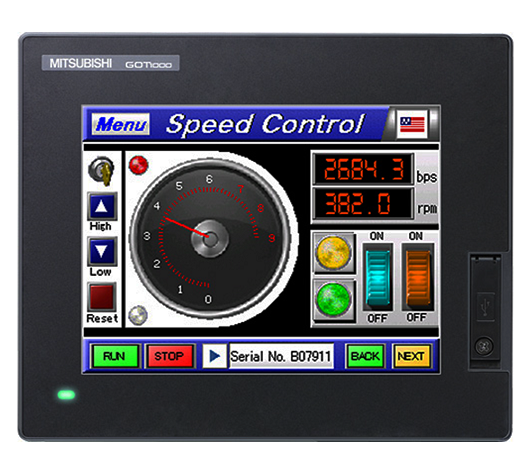1. EXECUTIVE SUMMARY
- CVSS v3 9.8
- ATTENTION: Exploitable remotely/low skill level to exploit
- Vendor: Mitsubishi Electric
- Equipment: GT14 model of GOT1000 Series
- Vulnerabilities: Improper Restriction of Operations within the Bounds of a Memory Buffer, Session Fixation, NULL Pointer Dereference, Improper Access Control, Argument Injection, Resource Management Errors
2. RISK EVALUATION
Successful exploitation of these vulnerabilities by an attacker may result in a denial-of-service condition or code execution.
3. TECHNICAL DETAILS
3.1 AFFECTED PRODUCTS
The following models of GOT1000 with CoreOS Version 05.65.00.BD and prior, a graphic operation terminal, are affected:
- GT1455-QTBDE
- GT1450-QMBDE
- GT1450-QLBDE
- GT1455HS-QTBDE
- GT1450HS-QMBDE
3.2 VULNERABILITY OVERVIEW
3.2.1 IMPROPER RESTRICTION OF OPERATIONS WITHIN THE BOUNDS OF A MEMORY BUFFER CWE-119
The affected product has a memory corruption vulnerability, which may allow an attacker to send a specially crafted packet that may result in a denial-of-service condition or code execution.
CVE-2020-5644 has been assigned to this vulnerability. A CVSS v3 base score of 9.8 has been calculated; the CVSS vector string is (AV:N/AC:L/PR:N/UI:N/S:U/C:H/I:H/A:H).
3.2.2 SESSION FIXATION CWE-384
The affected product has a session fixation vulnerability, which may allow an attacker to send a specially crafted packet that may result in a denial-of-service condition.
CVE-2020-5645 has been assigned to this vulnerability. A CVSS v3 base score of 7.5 has been calculated; the CVSS vector string is (AV:N/AC:L/PR:N/UI:N/S:U/C:N/I:N/A:H).
3.2.3 NULL POINTER DEREFERENCE CWE-476
The affected product has a NULL pointer dereference vulnerability, which may allow an attacker to send a specially crafted packet that may result in a denial-of-service condition.
CVE-2020-5646 has been assigned to this vulnerability. A CVSS v3 base score of 7.5 has been calculated; the CVSS vector string is (AV:N/AC:L/PR:N/UI:N/S:U/C:N/I:N/A:H).
3.2.4 IMPROPER ACCESS CONTROL CWE-284
The affected product has an access control issue, which may allow an attacker to send a specially crafted packet that may result in a denial-of-service condition or code execution.
CVE-2020-5647 has been assigned to this vulnerability. A CVSS v3 base score of 9.8 has been calculated; the CVSS vector string is (AV:N/AC:L/PR:N/UI:N/S:U/C:H/I:H/A:H).
3.2.5 IMPROPER NEUTRALIZATION OF ARGUMENT DELIMITERS IN A COMMAND (‘ARGUMENT INJECTION’) CWE-88
The affected product is vulnerable to an argument injection, which may allow an attacker to send a specially crafted packet that may result in a denial-of-service condition or code execution.
CVE-2020-5648 has been assigned to this vulnerability. A CVSS v3 base score of 7.1 has been calculated; the CVSS vector string is (AV:A/AC:L/PR:N/UI:N/S:U/C:N/I:L/A:H).
3.2.6 RESOURCE MANAGEMENT ERRORS CWE-399
The affected product has a resource management issue, which may allow an attacker to send a specially crafted packet that may result in a denial-of-service condition.
CVE-2020-5649 has been assigned to this vulnerability. A CVSS v3 base score of 5.3 has been calculated; the CVSS vector string is (AV:N/AC:L/PR:N/UI:N/S:U/C:N/I:N/A:L).
3.3 BACKGROUND
- CRITICAL INFRASTRUCTURE SECTORS: Critical Manufacturing
- COUNTRIES/AREAS DEPLOYED: Worldwide
- COMPANY HEADQUARTERS LOCATION: Japan
3.4 RESEARCHER
Mitsubishi Electric reported these vulnerabilities to CISA.
4. MITIGATIONS
Mitsubishi Electric recommends users update their products by downloading and applying the latest versions. For more information about steps to take to update to the newest version, please see the vulnerability information on the Mitsubishi website. To further reduce risk, restrict access to the product only from trusted networks and hosts. Contact a Mitsubishi Electric representative for additional details.
CISA recommends users take defensive measures to minimize the risk of exploitation of this vulnerability. Specifically, users should:
- Minimize network exposure for all control system devices and/or systems, and ensure that they are not accessible from the Internet.
- Locate control system networks and remote devices behind firewalls, and isolate them from the business network.
- When remote access is required, use secure methods, such as Virtual Private Networks (VPNs), recognizing that VPNs may have vulnerabilities and should be updated to the most current version available. Also recognize that VPN is only as secure as the connected devices.
CISA reminds organizations to perform proper impact analysis and risk assessment prior to deploying defensive measures.
CISA also provides a section for control systems security recommended practices on the ICS webpage on us-cert.cisa.gov. Several recommended practices are available for reading and download, including Improving Industrial Control Systems Cybersecurity with Defense-in-Depth Strategies.
Additional mitigation guidance and recommended practices are publicly available on the ICS webpage on us-cert.cisa.gov in the Technical Information Paper, ICS-TIP-12-146-01B–Targeted Cyber Intrusion Detection and Mitigation Strategies.
Organizations observing any suspected malicious activity should follow their established internal procedures and report their findings to CISA for tracking and correlation against other incidents.
No known public exploits specifically target these vulnerabilities.
Source:
